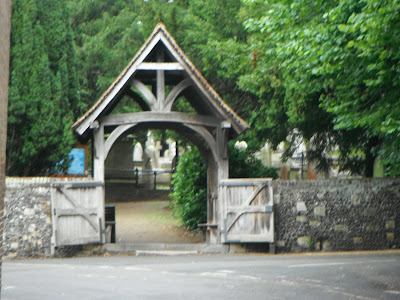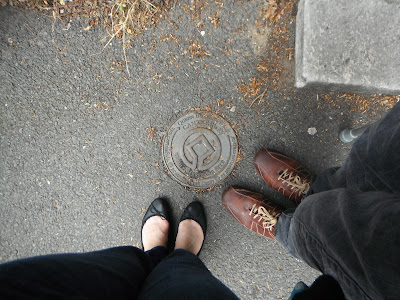This time I'm going to do things a little backwards.
The FINAL place we explored in Canterbury was St. Augustine's Abbey.
As I mentioned before, the central area of Canterbury doesn't have much, if any, information on how to get to the other two sites in the World Heritage Listings. You have to know that you want to go there and you have to be looking for them to find them.
But, now that you know about them, you simply must go.
The only directions are on sign posts and they are rather small. You'll be following something called Queen Bertha's walk the majority of the time but you won't know it. You should be aware that these signs will direct you out of city center and into Canterbury at large. This will be disconcerting but I promise you that you are going the right way (most likely- best to keep a map and keep looking for signs if you're really worried).
To enter St. Augustine's Abbey you first go through a little museum and pay £4.90 for adults and £4.40 for students. The museum, while small, gives an account of the Abbey and it's founding (around the same time as the Cathedral) through the Dissolution of the Church*, it's subsequent destruction and the rediscovery and excavation of the site.
The museum does offer audio tours but we opted to spend an extra £4 to get the guidebook and wander around ourselves. The guide book does have a tour in the back and I was lucky enough to have the most handsomest tour guide ever...
 |
| Ain't he cute?!! |
When you visit the Abbey please remember that it is only ruin's. Which I think is what makes it one of the best sites. There's no attempt to make it feel more "normal" for tourists and it's hard to see what makes it so special at first. But when you follow the tour and actually take in the information the site comes alive. The sheer expanse of it all is absolutely breathtaking when you imagine that it was all taken up by a church and small chapels. There was a part of the Abbey that wasn't demolished during the dissolution however, this has become a private school, King's School and no one but students and staff are allowed on the grounds (it's rather a shame because it's gorgeous).
 |
| It's Matt! Behind him you can see only about half of the expanse of the Abbey ruins. The buildings left whole are part of the school. In the skyline you can see the tip-top of the Cathedral |

Now, I've saved the best for last.
St. Martin's Church is way, way, way out there. About a 5 - 10 minute walk away from the Abbey. However, it is more than worth the walk. It's important to remember that the church is a working church so it's only open Tuesdays and Thursdays 11- 3 to tourists. Also, it is completely free! (I would leave a small £1 donation though, just to keep the church going)
 |
| You'll turn a corner and you'll see this. That means you're there! |
 |
| Our World Heritage marker!! You will see these periodically on the corners as you get close. |
 |
| The graveyard. Most of the graves are very old but not as old as the church. |

This is our absolute favorite place.
St. Martin's is the best of the three sites by far. It is the oldest working church in England. There is a sort of an air of romance around the place that you could probably explain with the knowledge that it was a wedding gift from King Ethelbert to his Queen Bertha (or maybe I just imagined it because Matt was there...)
It it modest, quiet, and quite far off the beaten track and that's what makes it so spectacular. Once you are within the walls, the mostly overgrown front graveyard has an ethereal nature about it. The only signs you're in a modern place is the welcome sign and the small railing for climbing the stairs (this is even painted green in an attempt to blend in with the surroundings).
Inside the church is modern, but not overly changed to cater to tourists. It is what is is. A small, humble, lovely little church.
 |
| Our absolutely favorite place <3 |
 |
| So simple, so calm, so lovely |
I should also mention that there are plenty of lovely and cheap places to eat. Some of them, like the Prezzo we ate at, are chains but they are very well done. There are small cafe's and tea rooms as well like Tiny Tim's Tea Room where you can enjoy a nice cream tea (though it is kentish and not devonshire which I'm told is a difference that means something).
That's all for today lovelies. I'll be back soon with stories about Central London and the easiest way to get around.
 |
| Kentish or not, Matt was still happy <3 |
x T




No comments:
Post a Comment